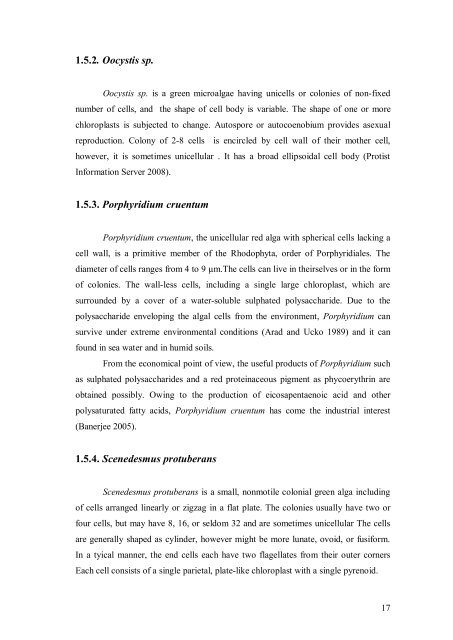BIOSORPTION OF Pb2+, Cd2+, & Ni2+ FROM WATERS BY ...
BIOSORPTION OF Pb2+, Cd2+, & Ni2+ FROM WATERS BY ...
BIOSORPTION OF Pb2+, Cd2+, & Ni2+ FROM WATERS BY ...
Create successful ePaper yourself
Turn your PDF publications into a flip-book with our unique Google optimized e-Paper software.
1.5.2. Oocystis sp.<br />
Oocystis sp. is a green microalgae having unicells or colonies of non-fixed<br />
number of cells, and the shape of cell body is variable. The shape of one or more<br />
chloroplasts is subjected to change. Autospore or autocoenobium provides asexual<br />
reproduction. Colony of 2-8 cells is encircled by cell wall of their mother cell,<br />
however, it is sometimes unicellular . It has a broad ellipsoidal cell body (Protist<br />
Information Server 2008).<br />
1.5.3. Porphyridium cruentum<br />
Porphyridium cruentum, the unicellular red alga with spherical cells lacking a<br />
cell wall, is a primitive member of the Rhodophyta, order of Porphyridiales. The<br />
diameter of cells ranges from 4 to 9 µm.The cells can live in theirselves or in the form<br />
of colonies. The wall-less cells, including a single large chloroplast, which are<br />
surrounded by a cover of a water-soluble sulphated polysaccharide. Due to the<br />
polysaccharide enveloping the algal cells from the environment, Porphyridium can<br />
survive under extreme environmental conditions (Arad and Ucko 1989) and it can<br />
found in sea water and in humid soils.<br />
From the economical point of view, the useful products of Porphyridium such<br />
as sulphated polysaccharides and a red proteinaceous pigment as phycoerythrin are<br />
obtained possibly. Owing to the production of eicosapentaenoic acid and other<br />
polysaturated fatty acids, Porphyridium cruentum has come the industrial interest<br />
(Banerjee 2005).<br />
1.5.4. Scenedesmus protuberans<br />
Scenedesmus protuberans is a small, nonmotile colonial green alga including<br />
of cells arranged linearly or zigzag in a flat plate. The colonies usually have two or<br />
four cells, but may have 8, 16, or seldom 32 and are sometimes unicellular The cells<br />
are generally shaped as cylinder, however might be more lunate, ovoid, or fusiform.<br />
In a tyical manner, the end cells each have two flagellates from their outer corners<br />
Each cell consists of a single parietal, plate-like chloroplast with a single pyrenoid.<br />
17

















